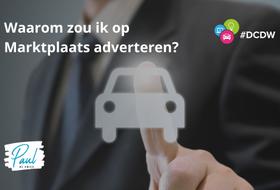
If the carsalesmen do not get better, then a BDC / CCC does not make any sense either!
26 december 2017, PaulThe key to success is not with a BDC / CCC or similar department

Many dealers switch to a BDC / CCC model to track leads, hoping to achieve better conversion. In the beginning there are often sweet stories that the conversion is going to get much better. If you look deeper, this is not always the case, but they now have an insight into the conversion, and that is a big step! Often people measure the success, the conversion to a sale from the appointment. How many leads there are before that, they often do not know, unfortunately. A conversion from appointment to sale should be + 50%.
I have mixed feelings about it myself, because I think the salesperson is the most suitable person to follow up leads in any form, and that a BDC / CCC model offers no added value. If you would like to change something, adjust all the peripheral issues that sellers have to do next to their main task: selling cars, and to do that job, they need leads. A salesman is now often used as a handyman, and that is not right. However, if this is not possible, then the BDC / CCC model can work fine for you, but only if the salesperson does understand that he / she still has to do something, which he does too little now: selling.
What do I mean?
In a BDC / CCC model, the salesperson does not have to process 100 leads anymore, but usually 36 qualified leads (60% rule), but when he handles those leads the same as he would handle 100, then the result is still moderate and you only have added more costs. What should the seller do better in this case? I would like to discuss three things with you.
1: An appointment is not a deal, yet
There are many discussions in dealerships between BDC / CCC departments and sales people, usually about the quality of the lead or appointment. The appointment comes in and show that he’s still a long way from buying and is still in the orientation. The seller thought that this would create a real chance, and calls the department, how they come to make an appointment with this customer. Does this sound familiar? In more than 90% of these cases, when you listen back to the conversation between the BDC / CCC and the customer, there is no reason not to make an appointment and the department has done the right thing.
The problem, however, is that – as a salesman – we already think we are there, and do not start building up value in the confirmation to the customer, in which we introduce ourselves as a salesman and explain our process so that the customer knows what we are going to do (proposal, test drive etc.). When the customer comes in, and starts directly in an RDR (Reactive Defensive Response), then we go along with it, and do not let us demotivate and undermine the sales process in the showroom. For example, if your sales process has 8 steps (greeting, introduction, need, presentation, test drive, proposal, negotiation and close), you simply start in step 1, even though your colleague has already done part of it.
2. No confirmation with an expectation
Suppose the CCC / BDC has made an appointment for you, then confirm this appointment yourself as a salesman. Send an e-mail, video with more information about yourself, who and what you are and what the customer can expect from the appointment. Something along the lines of: Dear Mr. de Vries, thank you for making the appointment here with us, on Friday the 13th. My job is to provide you with all the information, and after you have test driven in the car, you can also expect a concrete proposal, so that you can compare our proposal at home, in your own environment, with the research you have done. If you want to make a decision immediately, you can of course do so! If you’re going to run late, please let me know so that I can adjust my schedule for you. With kind regards … .etc.
3. Transfer is difficult
As long as people buy from people, the transfer is the most difficult in this model. After all, it is not desirable for anyone to talk to person X and then Y. If you ask the customer, he will say that he would like to be helped by one and the same person. This is not the case in this model, so the transfer is important. In your first conversation, and preferably when you are confirming the appointment, the seller is crucial. After all, they have just had a great conversation with the BDC / CCC and it is your job to keep them in that flow. Are you going to do something too commercial, you will find out that they were not as ‘hot’ as you thought. Use your colleague’s call data to get your customers at the same call level, so that the transfer goes smoothly.
Conclusion
In all the examples that I have from my own practice, the most successful BDC / CCC models are a combination of a good performing department and another adapted process for the sellers in the showroom how to deal with these qualified leads. Will they deal with it like they have always done, it will not bring you anything. Train your sales staff in better skills and processes, and then you will see that you get much more out of your chances than you do now.
About Paul de Vries
Paul de Vries became a Key Automotive Spokesperson at eBay (Marketplace) after selling Nieuweautokopen.nl to eBay back in 2015. Paul is the founder and CEO of the #DCDW and the presenter of the #DCDW Podcast. He is also a by dealers and importers frequently asked speaker in the online automotive industry. Paul is the winner of the prestigious Lighthouse Award 2016 in the U.S.! `Lead the Way op de digitale snelweg’ and “Follow-UP are Paul’s new books, which can be used as a guide in the online automotive industry. More information is available at: DCDW.nl.





